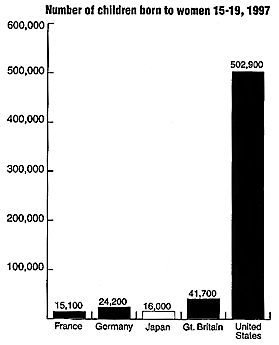Earth's Big Challenge
How to solve population growth
by Peter H. Kostmayer, special to the Free Press
"Of all the issues we face as the new millennium nears, none is more important than population growth. The numbers speak for themselves. Earth's population, which totaled 1. 7 billion people in 1900, is now nearly six billion and growing."

Teen birth rates are declining in the US, but this graph shows the drastic difference in births to teenage girls here and in several industrialized countries. Altogether teens in the US have some 900,000 pregnancies per year, with over half brought to term. Better sex education, access to birth control methods, defeating religion-based policies at every level, and parent support will help reduce teen births, says the ZPG Reporter, a publication of Zero Population Growth (www.zpg.org).
|
It may surprise some readers to know that the aforementioned quote isn't from a Zero Population Growth publication: it's taken from the October 1998 edition of National Geographic, which was devoted to the issue of population. Indeed, the world's population reached six billion last year, and it continues to grow at an alarming rate.
Why would one of America's most reputable, influential and impartial periodicals spend so much time and space on this issue? The numbers do speak for themselves. And perhaps more importantly, so do the quality of life issues so clearly related to rapid population growth.
With almost 276 million people, the U. S. is the third most populous country in the world. Our unintended pregnancy rate is nearly 50 percent and teen pregnancy is the highest in the industrialized world. We use a third of the world's energy and produce 25 percent of its solid waste. At current rates, we'll add another 140 million people by 2050. Population-related problems such as urban sprawl continue to assault our environment and communities, spew forth air and water pollution and erode the quality of our lives. Grid-locked traffic and the time and money wasted every year because of it can also be related to overpopulation.
At the moment, nearly one billion people on the planet are not getting enough to eat. And in the developing world, lack of access to reproductive health services is killing hundreds of thousands of mothers and their children every year.
The Worldwatch Institute's report Beyond Malthus: Sixteen Dimensions of the Population Problem vividly showed that some countries in the industrialized world are making some progress towards population stabilization--which is low birth rates balanced with low death rates. This progress is due, in no small part, to the decades of work to increase the status of women, to improve the lives of children and to give everyone a decent standard of living.
In the developing world, the report told a very different story. Many countries are still experiencing massive population growth and are stretched to the limit with population-related challenges. These overwhelming challenges include educating growing numbers of children, creating jobs for swelling ranks of young job seekers and dealing with the environmental effects of population growth such as deforestation, soil erosion and falling water tables.
As a direct result, many developing countries can't cope when other challenges come along, such as the AIDS epidemic. For example, in Zimbabwe the rate of HIV infection is a shocking 26 percent. In the industrialized world, the highest rate is just under one percent. This means that, barring the discovery of a miracle cure, Zimbabwe will lose a fifth or more of its adult population in the next decade and still have one of the highest birth rates in the world.
This appalling situation, which is not atypical in the developing world, means some countries are facing the highly unstable prospect of exploding birth rates and exploding death rates. What can we do to tackle these awesome challenges? There are many things, but perhaps the most important, in my opinion, relates to the world's women.
Every woman, everywhere, should be empowered with better access to safe, effective and affordable family planning services. In this day and age, a woman should be able to easily plan and space the number of children she wishes to have. Most insurance companies in America still refuse to cover contraceptives. In turn, American women spend 70 percent more than men in out-of-pocket health costs. Full contraceptive coverage will slash these costs for millions of women and provide insurance companies with big medium and long-term savings.
In turn, better access to contraceptives reduces abortion rates. This means that even anti-choice lawmakers can support on-going bipartisan initiatives to pass legislation that requires health insurers to provide full contraceptive coverage. Our nation's vital Title Ten family planning program is designed to help women on low incomes get access to the family planning services they want. Yet millions are not getting it because of chronic under-funding. Between the years of 1980 and 1992 alone, the program was slashed by a shocking 72 percent. It should be properly funded.
Abroad, there must be a speedy expansion of our international family planning funding and more investment in education for young people--particularly young women--in the developing world. The US supports voluntary family planning initiatives in the world's poorest countries. These programs help save the lives of millions of poor women and children every year by providing safe family planning services, specialized training for doctors and nurses and assistance to other agencies in their education efforts.
Or as Secretary of State Albright hammers home, the program "raises the status of women, stems the flow of refugees, protects the environment, promotes economic growth and reduces abortion. "The truth is that if every child is planned and wanted, we'll have a better, less crowded, world.
Peter H. Kostmayer is a seven-term veteran of the U. S. House of Representatives and a former senior EPA official in the Clinton Administration. He is President of Zero Population Growth (ZPG), a non-profit environmental organization working to educate people about the impact of rapid population growth.
